Amonkhet Down to Business, Part 1
Welcome to the first week of Amonkhet previews. Today, I'm going to begin explaining how the set came about, introduce you to the design team, and reveal a pretty sweet preview card. Hopefully, that sounds like fun.
In the Beginning
Our story begins years ago. We knew we wanted a top down block and we were interested in it being culturally based, most likely tied to that area's older mythology, but there was a lot of debate over which influence we should pick. We looked at all sorts of real world sources from Norse to Native American to Aboriginal Australian. In the end, we came down to two choices—Japanese and Egyptian.
Both cultures were relevant in pop culture, meaning awareness was pretty high. Both had strong iconography and a distinctive visual look. Both had a rich mythology to draw from that we knew would allow us to make cool Magic creatures. Each side had its fans, not to mention the player base, which had been asking for both for years, so we spent a lot of time going back and forth between the choices.
In the end, we couldn't decide and the decision went all the way up the chain to Bill Rose. Bill admitted that both choices were good and he'd like us to one day do the one he didn't pick, but after careful decision Bill made his choice—we're going with Japan.
And that is how we decided to make Champions of Kamigawa.
I bring up this story because I think it's important to understand that we almost made an Egyptian themed set back in 2004. It's something that has been on our minds for a long time. The big question for today's column is, how did we finally choose to do it now? That's a great question. One I will answer after I introduce you to the set's design team.
Ethan Fleischer (co-lead)

Ethan got his job at Wizards by winning the second Great Designer Search. Ethan has been on numerous design teams and exploratory design teams, many of which he led (Journey into Nyx, Commander (2014 Edition), Oath of the Gatewatch, and Commander (2016 Edition)). He was realizing all the potential we saw when he won the GDS, and it was time for him to try a bigger challenge, so we gave him Amonkhet (which he co-led with me, more on why below). Ethan was up for the challenge and, along with his team, designed a pretty cool top-down Egyptian set (and also a top-down Nicol Bolas set—more on that below).
Kimberly Kreines
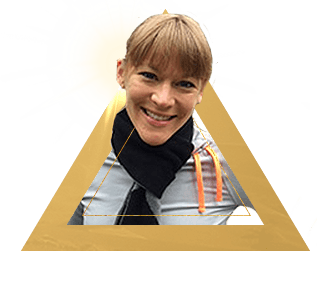
Kimberly was our creative representative. It was her job to make sure the design matched the story and world. This was the first time I had worked closely with Kimberly, and she was awesome. She was so excited every meeting and had endless suggestions about how we could better link mechanics with creative. The strong link between the mechanics and creative is due much to Kimberly's hard work.
Jackie Lee

This was also Jackie's first time on one of my design teams. Jackie's Magic background is from the competitive world of the Pro Tour, but her outlook on the game and its design is unlike most former pros. Jackie always approached the design from a different vantage point, and that fresh perspective helped the team often look at our work in a new light.
James Hata

James was borrowed from the Duel Masters team. Duel Masters is a trading card game we make primarily for the Japanese market. (If you want to hear more about it, I did a "Drive to Work" podcast about the creation of its original design last month.) It's always cool to bring in a designer from a different game to get some cross-pollination. James is an excellent designer and made a lot of cards you all are going to get to enjoy. He is also a lot of fun to tease.
Shawn Main

Shawn Main was the runner-up from the second Great Designer Search. Like Ethan, he's been on a lot of design teams and led Conspiracy (which was also his brainchild), Magic Origins, Conspiracy: Take the Crown, and Kaladesh (which he co-led with me). Shawn was the lead designer for Hour of Devastation, so he joined halfway through the Amonkhet design to acquaint himself with the world and mechanics that he was going to follow up. Shawn is excellent at finding new ways to shape designs and was a welcome addition. For those counting, this was a large design team. Shawn's addition made it seven people, the largest design team we've ever run (with everyone in the room at one time—we've had design teams where more people were involved during the duration of the design).
Sam Stoddard
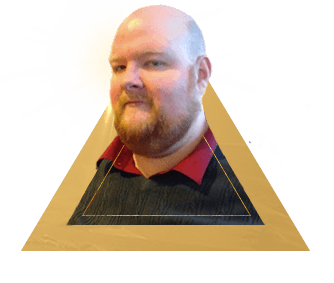
Sam was the development representative. His job was to cost the cards and make sure we weren't signing development up for something that couldn't be properly balanced. He also did a bunch of cool designs. Sam led the development for Magic Origins, Eldritch Moon, and this year's fall set (spring for the Southern Hemisphere). After a month and a half, Sam's skills were needed elsewhere, and he transferred to a different team.
Ben Hayes

Which is when we got Ben as our new development representative. Ben had led the development for Commander (2015 Edition), Conspiracy: Take the Crown, Commander (2016 Edition), and Aether Revolt. Ben has proven to have both strong design and development skills and was a great addition to the team. That is, until Ben too was needed elsewhere and was transferred off the design team after two and a half months.
Yoni Skolnik

Which brings us to Yoni, our third development representative. At this point we were a little burned by all the rejection we'd received from our former development representatives and didn't want to get emotionally attached so when he joined the team, we just referred to him as "DR3" (as he was the third development representative). Yoni eventually earned his name because he a) did great work and b) didn't abandon us. This was the first time I'd worked with Yoni on a design team, and I hope to have the opportunity many more times. Design often asks a lot from the development representatives, because we're asking them to solve problems for things that they often have zero previous experience with. Yoni was always insightful and made an excellent development representative.
Mark Rosewater (co-lead)

I haven't talked a lot about the impacts of the new two-block model (I have an article scheduled for later this year where I go into detail), but one of the biggest new hurdles was I needed a way to help set vision for each of the large sets. As there were now two per year, the system I came up with was to lead the first half of each of the large sets and then hand it off to another designer for the second half. As both Ethan and Shawn hadn't designed an "expert-level" large set before (Shawn had done Magic Origins), this also allowed me to ease them into their first large set design.
The Trip to Egypt
Our story (well, this part of the story) begins at an offsite not too far from the Wizards offices. The upper management of Magic R&D was having an all-day meeting to try to figure out the next few years of the game (at the end of the part we had already figured out—we work far ahead). One of the first things we did was to write on a giant pad every world concept that we could think of but hadn't yet done. The inspiration for the world could come from any source including mechanical and creative. Aaron had tasked me with making a list of the many worlds players had been asking for over the years. At the top of that list was an Egyptian-inspired world, so I wrote it on the pad.
Next we wrote down a bunch of the different ideas for stories that the creative team was interested in telling. Remember at this point, the Gatewatch had been formed. We then looked at all the world ideas and all the stories ideas and figured out if there were any good synergies. At some point soon after, maybe even at the meeting, the idea of the Egyptian setting being tied to Bolas came up. What if Bolas, in his previous more powerful incarnation, made the Egyptian-inspired world? Everyone agreed that was pretty cool.
We had wanted to bring Bolas back and the world seemed like a great fit, plus we knew it was something the audience had been asking for, so it ended up making it onto the initial plan. We would first visit the Egyptian-inspired plane, and then we would visit Chandra's steampunk-ish home world of Kaladesh.
It wasn't until we were halfway through Amonkhet exploratory design that we realized that the story worked better if Kaladesh went first, so we scrambled and changed the two around. Shawn had originally been scheduled to co-lead Amonkhet because he had spent numerous years of his youth living in Egypt and had a good working knowledge of Egyptian mythology. The scheduling unfortunately couldn't change (I will spare you the details of the complexity of scheduling 45 people) so Shawn stayed and co-lead the design for Kaladesh. (We did give him the design lead of Hour of Devastation to let him lead the design of an Egyptian-themed set.) That meant Ethan was going to be leading the design along with me.
I started Amonkhet design with two givens. I wanted the block to be both top-down Egypt and top-down Bolas. That led to the question, how much of the block was top-down Egypt versus how much was top-down Bolas? Obviously the two had a decent amount of overlap, which is what made the combination so good, but each was going to want to have things that didn't necessarily belong with the other. In the end, we decided that Amonkhet was going to be mostly top-down Egypt with some top-down Bolas and Hour of Devastation was going to be mostly top-down Bolas with some top-down Egypt.
At the first meeting, I did what I normally do with a top-down design: I had my team brainstorm what the audience would expect of each. Every suggestion went up onto the white board in one of three lists: top-down Egypt, top-down Bolas, or top-down Egypt and Bolas.
We're going to begin by examining the Top-Down Egypt list.
Gods
This was the very first thing we wrote down, and it's the thing players most asked me about when they first found out we were doing an Egyptian-inspired set. A top-down design needs to reach a certain amount of expectation, which means the set inspired by Egyptian mythology had to have Gods.
The challenge of designing Gods was we'd done them once before in Theros block (I'm talking about creatures with the creature type God—we'd done creatures flavored as Gods numerous times). The Amonkhet Gods were going to be measured against the Theros Gods, and if we wanted them to be different in any way, we needed to figure out what the mechanical through line was for Gods. As an old math teacher loved to say, once you have two points, you have a line. Whatever we did in Amonkhet would begin defining what exactly it meant mechanically to be a God.
We started by looking at the Theros Gods.
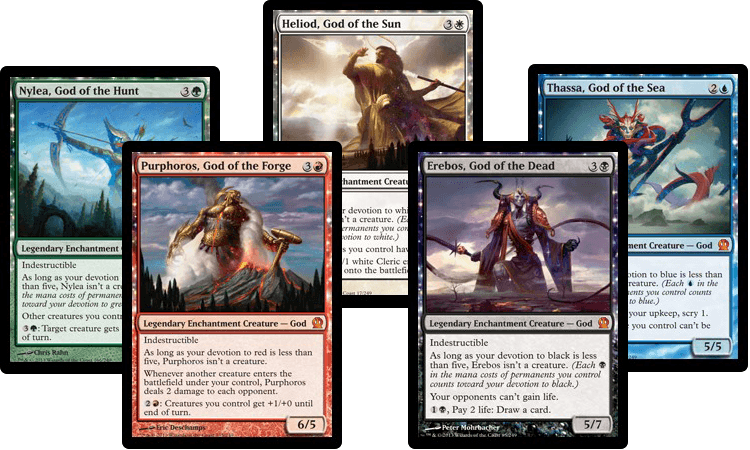
We then broke them down into their component parts:
- Creature type God
- Enchantment creatures
- Indestructible
- Only creatures conditionally (for Theros the condition used devotion)
- Static ability
- Activated ability (while all the monocolored Gods had this, all fifteen did not)
- Good mana cost/power & toughness ratio
Let's examine each one.
Creature type God
This one's mandatory. Egyptian Gods, regardless of any other factor, would upset the players if they weren't creature type God.
Enchantment creatures
This one was off the table. In Theros, we used enchantments to express the touch of the Gods. If enchantments don't play a major role (and we didn't want them to, as we wanted some distance from Theros), it wouldn't make any sense for the Gods to be enchantment creatures.
Indestructible
Gods are hard to kill. This conveys that in one word, so pretty elegantly. On the flip side, large, indestructible creature are tough to balance.
Only creatures conditionally
This was the quality that the majority of the design team equated with being a God. The idea that a God has influence and only under certain circumstances appears in creature form is pretty flavorful.
Static ability
This did a good job of making the God have relevance even if you haven't managed to make them into a creature yet.
Activated ability
This does similar work to the static ability.
Good mana cost/power-toughness ratio
This is the one relational item on the list. The only reason this one is true is because of the conditionality of the creature. Having to jump through hoops before it can become a creature allows you to be aggressive with the mana cost/power-toughness ratio.
So where did we end up? Luckily, my preview card today is a God. Let's see it.
World, I'd like you to meet Hazoret the Fervent, the red God.
Click here to meet Hazoret.
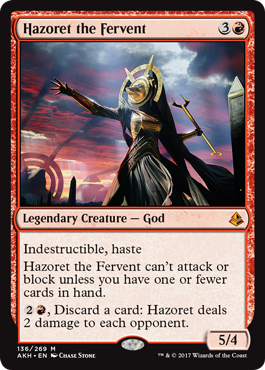
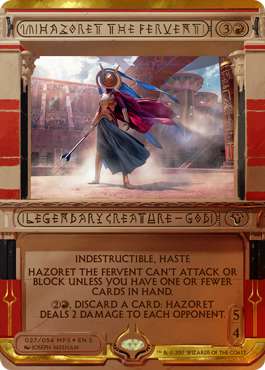
So, we kept the following:
Creature type God
Obviously.
Indestructible
There was much debate on this one, but in the end decided it worked on these five cards.
Only creatures conditionally
This one had the biggest tweak. Instead of being a creature conditionally, Hazoret can only attack or block conditionally. Being that attacking and blocking is a big part of what a creature can do, especially creatures as big as the Gods, it's similar in nature while being a little easier to understand.
Activated ability
We liked the idea that the God has influence even if they haven't met their condition yet. We felt that it could be either static or activated and chose activated because it worked better for this set.
Good mana cost/power-toughness ratio
The conditional attack or block enabled us to do this.
Note that we purposefully overlapped quite a bit to give us some flexibility for the next time we do Gods, the thought being we will need some overlap but not total overlap.
Amonkhet has a cycle of five monocolor Gods. They each have two keyword abilities, one of which is indestructible. They have a condition they need to meet to be able to attack and block and then they have an activated ability that helps them reach that condition. Creatively, to match the source material, all the Gods are animal-headed.
Mummies
The next thing we wrote up on the board was "mummies" because, really, how are you going to do an Egyptian-inspired set without mummies? To the best of my knowledge, these are the four mummies previously extant in Magic:
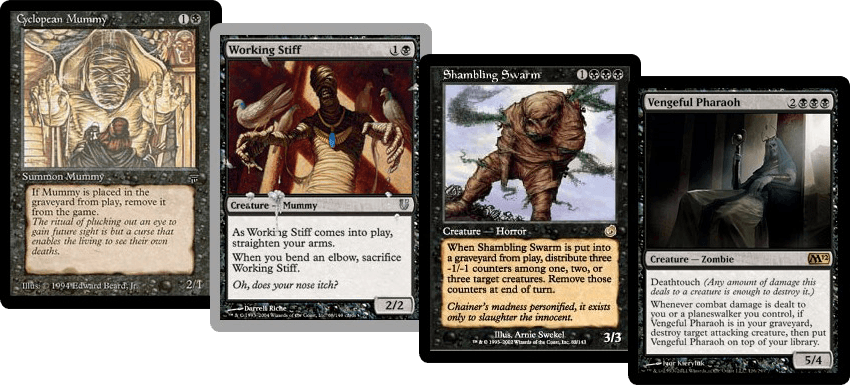
Cyclopean Mummy is from Legends (1994), Shambling Swarm is from Torment (2002), Working Stiff is from Unhinged (2004), and Vengeful Pharaoh is from Magic 2012 (2011—confusing, I know). The Grand Creature Update that happened after the first three were printed removed Mummy as a creature type and turned it into Zombie. (Shambling Swarm was a Horror originally.) That's convenient, as Amonkhet will be in Standard with Shadows over Innistrad block, which has a Zombie tribal theme.
We were in a very similar place to Innistrad with the Werewolves, in that we only had a handful of cards in the game's past that touched upon the flavor. The big question was what colors did we want the mummies in? Remember that I like tribes to be in a least two colors if we're going to give them a significant tribal theme. It greatly increases the deck-building and design options. To play with the Shadows over Innistrad Zombies, they needed to be blue or black. If you wanted to play with Zombies in general (Magic has had a lot of Zombie tribal over the years), you really wanted the Zombies to be black, as outside of Innistrad, that's the color of most Zombies historically.
We ruled out blue Zombies because we felt Innistrad had set the flavor that blue Zombies were created through science/magic, and mummies didn't feel at all like Frankenstein-style creatures. Red Zombies didn't feel right as mummies don't really have a red mindset. Green Zombies seemed odd, as mummification seemed a very unnatural process. That brought us to white. Mummification had a ritualistic and orderly aspect to it. Was there a way to make white Zombies work?
So, we went to the creative team and asked what they thought of white and black Zombies. It turns out they had created a society within the city where Zombies served as servants and outside the city where they became abominations. White and black were perfect fits. To differentiate between the two, we made the black Zombies destructive and the white Zombies constructive. The black Zombies were vicious in combat and had effects that often would injure or kill other creatures. In exploratory design, we had played around with wither, so I added it to a bunch of the black mummies. (The set had -1/-1 counters. I'll be getting to this in future weeks. I'll also be getting to how wither got added and then removed.) The white Zombies, in contrast, were made to be mechanically helpful to portray their servant status.
I liked the dynamic of Amonkhet having white and black Zombies and Shadows over Innistrad having blue and black Zombies, because it allowed a variety of different Zombie decks in Standard. Most of them would be base black but allow you to splash (or not splash) in a few different ways.
Ethan liked what we had done with the Zombies but wanted to go a little further, so right after I handed the reins to him, he added a new mechanic to the file—something that would add an aspect of mummies we hadn't hit yet.
And I'll tell you all about it in part 2 next week.
Amonkhet Out of Here
Yes, we're sadly out of time for today, but luckily we have two more weeks to tell the tale of Amonkhet's design. As always, I'm eager for feedback, on today's column, on Amonkhet, or on whatever topic you're eager to talk to me about. You can send me an email or contact me through social media (Twitter, Tumblr, Google+, and Instagram).
Join me next week as I talk about the creation of embalm and several other cool mechanics.
Until then, may you avoid the curse of a mummy.
Featured
#422: Behind the Scenes
Featured
#422: Behind the Scenes
This podcast is a look at the behind-the-scenes of the "Drive to Work" podcast. Very meta.
Featured
#423: Virtual Tour
Featured
#423: Virtual Tour
36:09
Wizards of the Coast doesn't give public tours, but occasionally we give them for special guests. As someone who has done a lot of these tours, I thought it would be fun to do one for all of you, virtually.
- Episode 421 Strengths and Weaknesses (24.1 MB)
- Episode 420 Top 10 Cool Things About R&D (31.7 MB)
- Episode 419 Around the World (24.9 MB)

